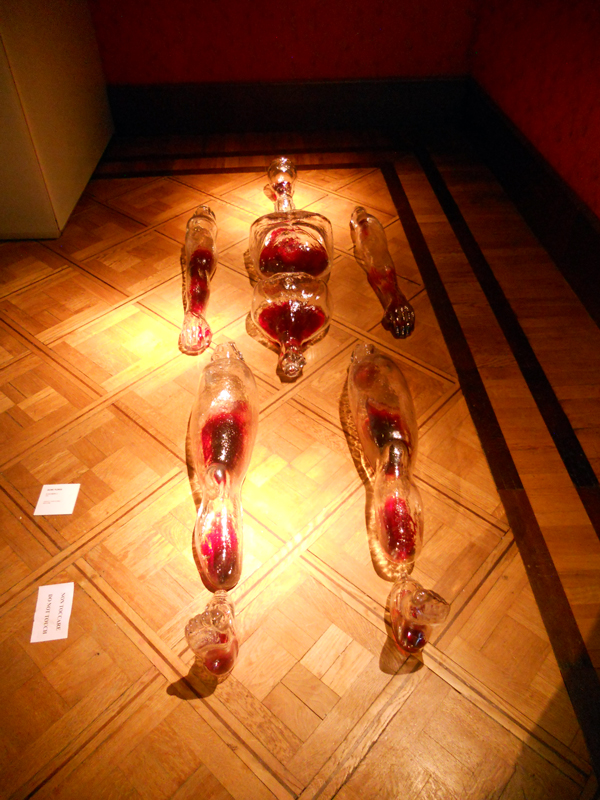

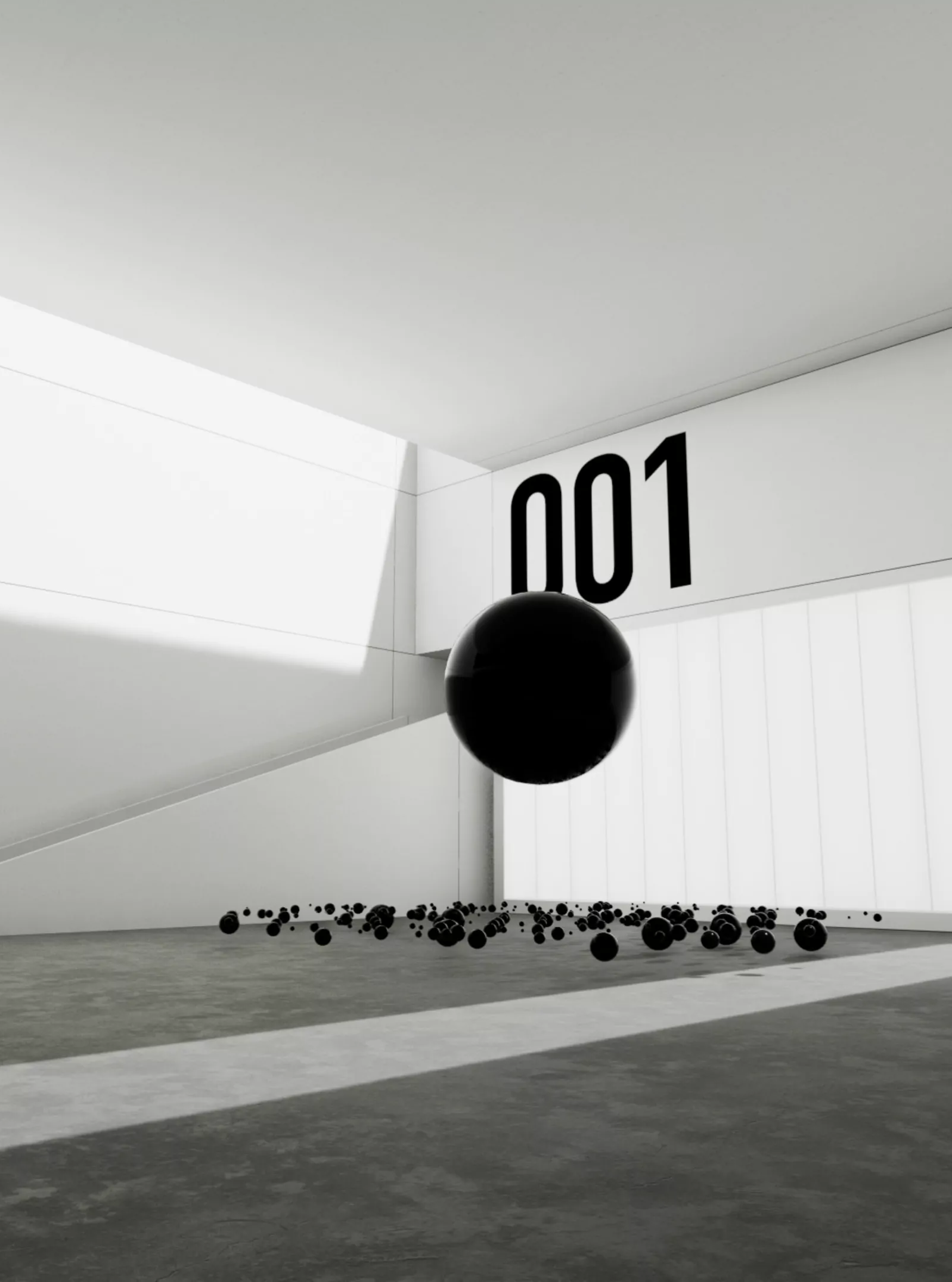
Maxim Zhestkov
Modules
Modules is a VR art experience, where architecture, sculpture, film, and music blend together to immerse viewers into Zhestkov’s world. A total work of art, it is a world that questions the established definitions of our reality. In digital space, we can abandon the logic of reality and are freed from its boundaries. New worlds with total freedom are possible, worlds only limited by our creativity and the potential of art.

Maxim Zhestkov
Simulation Hypothesis
In Simulation Hypothesis, Zhestkov equally seeks inspiration in pre-historic cultures of cave art and ancient bas-reliefs. He plays with a visuality that precedes written language, from a time in which early humans used clay to make vessels and figurines.
The artist uses the inspiration from ancient forms of art and transforms it into digital sculptures using simulations and algorithms based on principles of nature.
The show takes viewers on a conceptual journey, immersing them first in Clouds of Creation, a large-scale projection that recreates the Big Bang, and then guiding them through micro manifestations of this transformative moment of genesis.

Refik Anadol
Machine Hallucinations — Sphere
The artwork presents a series of AI Data Sculptures that incorporates vivid pigments, shapes, and patterns, aiming to create a collective, meditative, and multisensory experience. This immersive experience simulates the rhythms of various environments and invites the visitors to imagine alternative realities constructed by invisible data movements around them.
Machine Hallucination: The Sphere features dynamic visualizations of data that are based on vast archives containing visual imageries of space and nature while celebrating the unique architecture of The Sphere. For this project, Anadol and his team used these themed datasets as the building blocks for the three distinct chapters of the artwork and trained a unique AI model with subsets of the collected image archives. After the training, when idle and unsupervised, the “machine mind” generates new aesthetic visuals and color combinations through unique lines drawn by algorithmic connections.

QUBIT AI – International Electronic Language Festival – Art and Technology
QUBIT AI | quantum & synthetic ai
Electronic Language International Festival
July 3rd to August 25th
Tuesday to Sunday, 10am – 8pm
FIESP Cultural Center
Design: André Lenz
Image: Iskarioto Dystopian AI Films – Athena
QUBIT AI
In its 25 years of existence, the International Electronic Language Festival (FILE) is an internationally renowned Brazilian project that since 2000 has explored the intersection between art and technology. With more than two decades of history, the festival stands out for fostering exhibition spaces and debate about artistic innovations driven by disruptive and innovative technologies, inviting the public to get involved with experimental forms of art that challenge the boundaries of conventionality. Currently, two of these technologies stand out in the contemporary scenario: the accelerated development of quantum computing and artificial intelligence corroborated by synthetic data.
Quantum computing, an emerging revolution in the technological field, offers a new range of creative possibilities for contemporary artists. This new era allows the exploration of unprecedented frontiers through a new computational format that consists mainly of quantum superposition and entanglement, a new field of exploration for synthetic computer science, as well as for the arts in general; on the other hand, artificial intelligence, fueled by synthetic data, offers artists a new way of making and understanding art, opening up space for new forms, concepts and artistic expressions.
Entitled QUBIT AI, the exhibition delves into this unexplored territory presenting a selection of works of art resulting from the connection between artistic creation and technology, proposing a theoretical reflection on what the interrelationship between quantum computers and synthetic artificial intelligence will be.
Visitors will be invited to experience immersive installations, experimental videos, digital sculptures and other forms of interactive art, which intertwine reality and imagination. The exhibition encourages reflections on the influence of technology on art and contemporary society, while at the same time providing an environment to compare already established technological arts (analog and digital) with the possible futures of art in the synthetic era, enhanced by quantum computing. The QUBIT AI exhibition at FILE SP 2024 transcends the mere presentation of works of art; it is a journey to the limits of human creativity, driven by the convergence of art, science and technology.
Ricardo Barreto and Paula Perissinotto
co-organizers and curators of FILE
International Electronic Language Festival
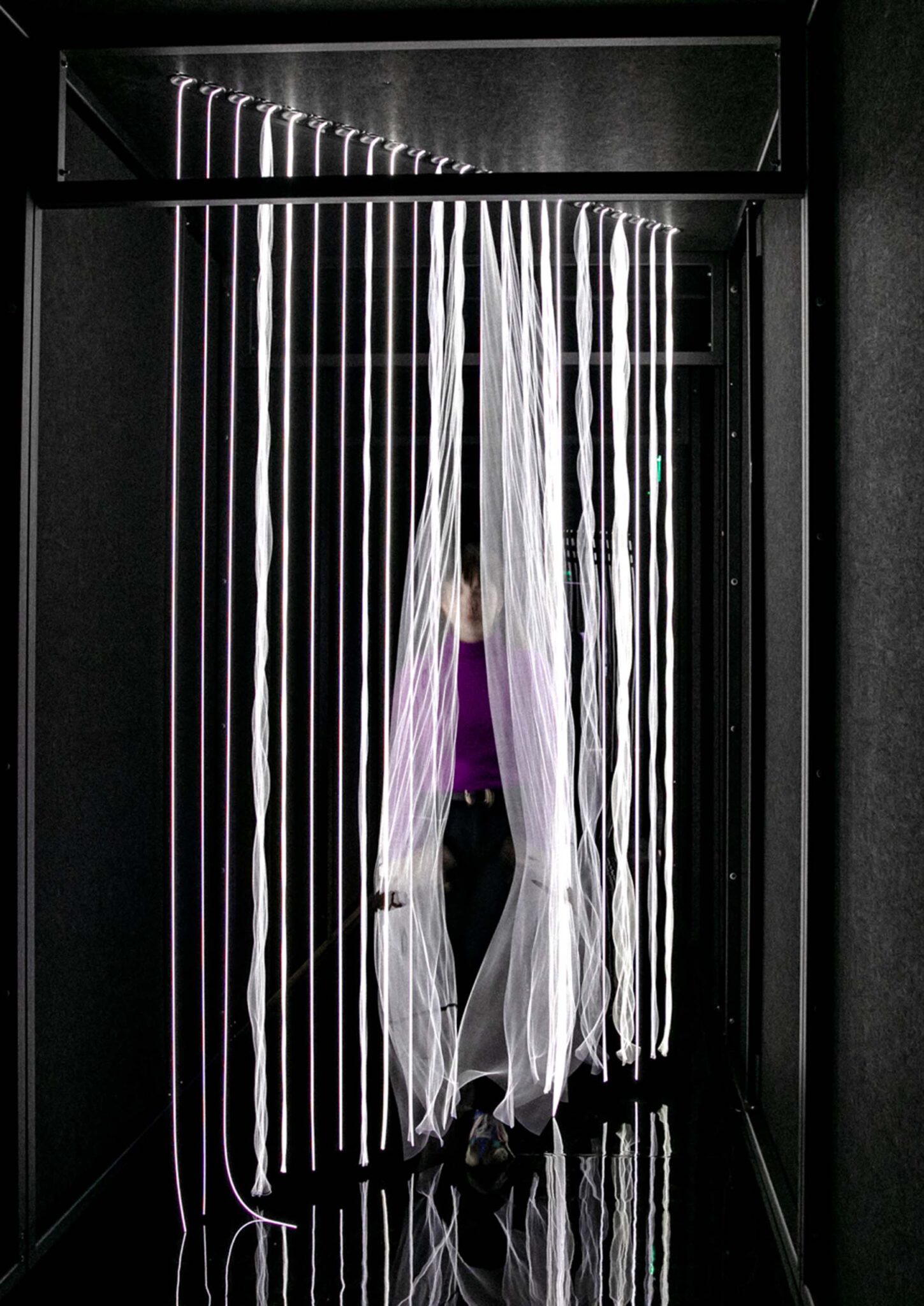
QUBIT AI: Marc Vilanova
Shell of
FILE 2024 | Installations
International Electronic Language Festival
Marc Vilanova – Cascade – Spain
Waterfalls are a continuous source of infrasonic frequency found in nature. Although inaudible to humans, they play a crucial role in ecosystems, especially for migratory birds who use them as a compass. However, many waterfalls have lost their frequencies due to climate change. The work creates an immersive experience in which the audience interacts with the visualization of sound waves, experiencing the vibration of sound through illuminated strings.
Bio
Marc Vilanova is a sound and visual artist who works at the intersection of art, science and nature. Vilanova’s artistic production has always been led by a spirit of innovation fueled by an interest in new media. His practice combines sound/light installations, performance, and sculpture.
Credits
This work was partially carried out within the scope of the EMAP program at gnration, with the support of the Creative Europe Culture Programme, the Avatar Center in Quebec City and the Ramon Llull Institute.
Photo:
Eloise Coomber
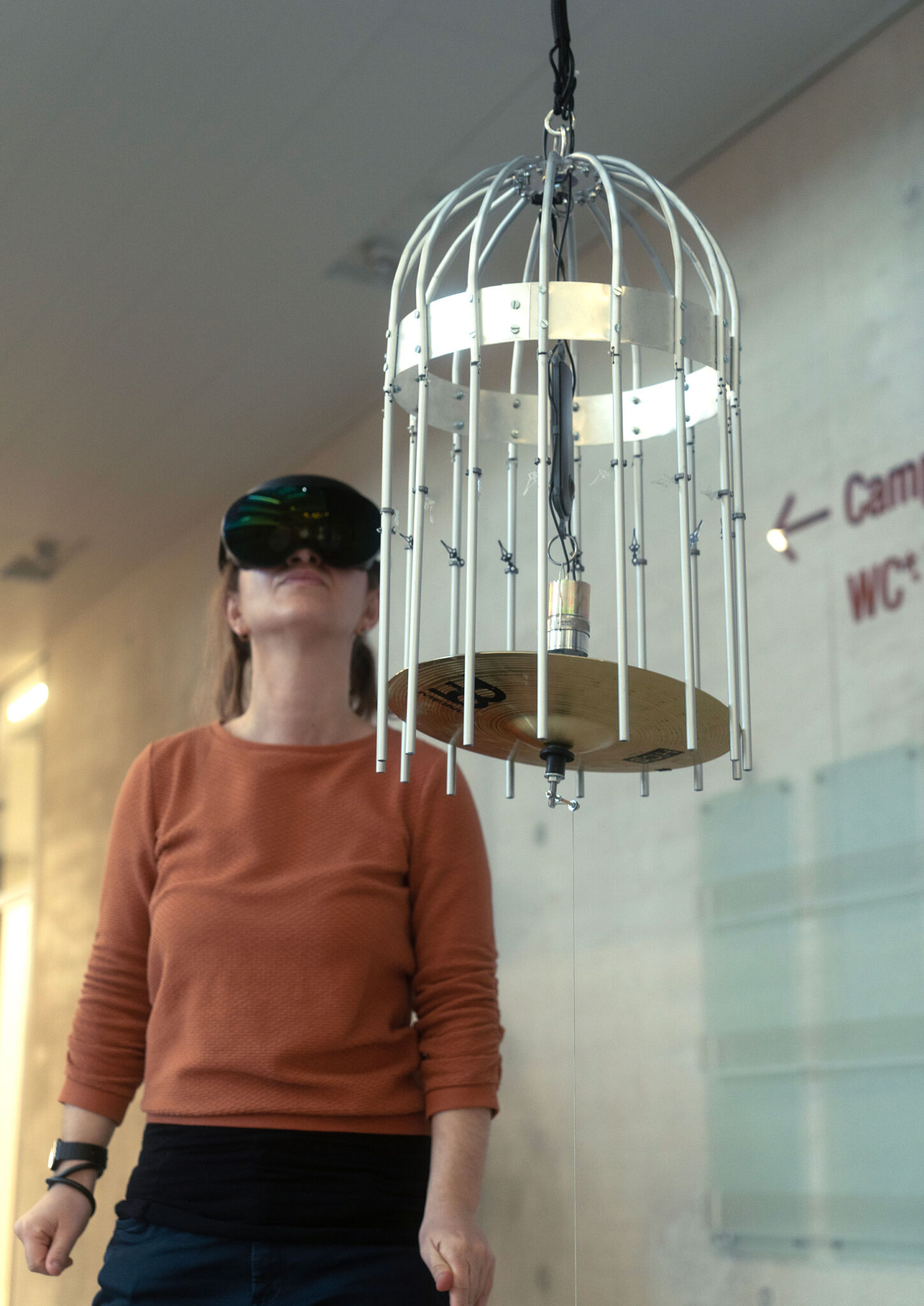
QUBIT AI: Anna Vasof & VRinMotion Team
The Cage of Time
FILE 2024 | Installations
International Electronic Language Festival
Interactive installation that presents a kinetic instrument object and virtual reality glasses, functioning as a device that animates the illusion of the passage of time in virtual space. In the fabric of existence, time weaves a cage around our ephemeral moments, limiting our perceptions of the past, present and future. By embracing this paradox, we may discover that the cage of time becomes the crucible where the alchemy of experience transforms our understanding of existence.
Bio
Anna Vasof is a multi-award-winning artist who focuses on filmmaking, short videos, and time-based sculptures. VRinMotion is an artistic research project based at St. Pölten University of Applied Sciences in Austria that investigates how features of stop-motion animation and motion capture can be combined with virtual reality to enrich current artistic discourse.
Credits
VRinMotion Team: Franziska Bruckner, Christoph Schmid, Clemens Gürtler, Matthias Husinsky, Christian Munk, Julian Salhofer, Stefan Nebel, Vrääth Öhner.
Concept by: Anna Vasof.

QUBIT AI: AESTHETIC SYNTHETIC FILE – São Paulo 2024 – Art and Technology
FILE 2024
QUBIT AI | quantum & synthetic ai
Electronic Language International Festival
July 3rd to August 25th
Tuesday to Sunday, 10am – 8pm
FIESP Cultural Center
Design: André Lenz
Image: Iskarioto Dystopian AI Films – Athena
QUBIT AI
In its 25 years of existence, the International Electronic Language Festival (FILE) is an internationally renowned Brazilian project that since 2000 has explored the intersection between art and technology. With more than two decades of history, the festival stands out for fostering exhibition spaces and debate about artistic innovations driven by disruptive and innovative technologies, inviting the public to get involved with experimental forms of art that challenge the boundaries of conventionality. Currently, two of these technologies stand out in the contemporary scenario: the accelerated development of quantum computing and artificial intelligence corroborated by synthetic data.
Quantum computing, an emerging revolution in the technological field, offers a new range of creative possibilities for contemporary artists. This new era allows the exploration of unprecedented frontiers through a new computational format that consists mainly of quantum superposition and entanglement, a new field of exploration for synthetic computer science, as well as for the arts in general; on the other hand, artificial intelligence, fueled by synthetic data, offers artists a new way of making and understanding art, opening up space for new forms, concepts and artistic expressions.
Entitled QUBIT AI, the exhibition delves into this unexplored territory presenting a selection of works of art resulting from the connection between artistic creation and technology, proposing a theoretical reflection on what the interrelationship between quantum computers and synthetic artificial intelligence will be.
Visitors will be invited to experience immersive installations, experimental videos, digital sculptures and other forms of interactive art, which intertwine reality and imagination. The exhibition encourages reflections on the influence of technology on art and contemporary society, while at the same time providing an environment to compare already established technological arts (analog and digital) with the possible futures of art in the synthetic era, enhanced by quantum computing. The QUBIT AI exhibition at FILE SP 2024 transcends the mere presentation of works of art; it is a journey to the limits of human creativity, driven by the convergence of art, science and technology.
Ricardo Barreto and Paula Perissinotto
co-organizers and curators of FILE
International Electronic Language Festival

QUBIT AI: FILE QUANTUM WORKSHOP 2024 – São Paulo – Art and Technology
FILE 2024
QUBIT AI | quantum & synthetic ai
Electronic Language International Festival
July 3rd to August 25th
Tuesday to Sunday, 10am – 8pm
FIESP Cultural Center
Design: André Lenz
Image: Iskarioto Dystopian AI Films – Athena
QUBIT AI
In its 25 years of existence, the International Electronic Language Festival (FILE) is an internationally renowned Brazilian project that since 2000 has explored the intersection between art and technology. With more than two decades of history, the festival stands out for fostering exhibition spaces and debate about artistic innovations driven by disruptive and innovative technologies, inviting the public to get involved with experimental forms of art that challenge the boundaries of conventionality. Currently, two of these technologies stand out in the contemporary scenario: the accelerated development of quantum computing and artificial intelligence corroborated by synthetic data.
Quantum computing, an emerging revolution in the technological field, offers a new range of creative possibilities for contemporary artists. This new era allows the exploration of unprecedented frontiers through a new computational format that consists mainly of quantum superposition and entanglement, a new field of exploration for synthetic computer science, as well as for the arts in general; on the other hand, artificial intelligence, fueled by synthetic data, offers artists a new way of making and understanding art, opening up space for new forms, concepts and artistic expressions.
Entitled QUBIT AI, the exhibition delves into this unexplored territory presenting a selection of works of art resulting from the connection between artistic creation and technology, proposing a theoretical reflection on what the interrelationship between quantum computers and synthetic artificial intelligence will be.
Visitors will be invited to experience immersive installations, experimental videos, digital sculptures and other forms of interactive art, which intertwine reality and imagination. The exhibition encourages reflections on the influence of technology on art and contemporary society, while at the same time providing an environment to compare already established technological arts (analog and digital) with the possible futures of art in the synthetic era, enhanced by quantum computing. The QUBIT AI exhibition at FILE SP 2024 transcends the mere presentation of works of art; it is a journey to the limits of human creativity, driven by the convergence of art, science and technology.
Ricardo Barreto and Paula Perissinotto
co-organizers and curators of FILE
International Electronic Language Festival

QUBIT AI: FILE OPENING LECTURE 2024 – São Paulo – Art and Technology
FILE 2024
QUBIT AI | quantum & synthetic ai
Electronic Language International Festival
July 3rd to August 25th
Tuesday to Sunday, 10am – 8pm
FIESP Cultural Center
Design: André Lenz
Image: Iskarioto Dystopian AI Films – Athena
QUBIT AI
In its 25 years of existence, the International Electronic Language Festival (FILE) is an internationally renowned Brazilian project that since 2000 has explored the intersection between art and technology. With more than two decades of history, the festival stands out for fostering exhibition spaces and debate about artistic innovations driven by disruptive and innovative technologies, inviting the public to get involved with experimental forms of art that challenge the boundaries of conventionality. Currently, two of these technologies stand out in the contemporary scenario: the accelerated development of quantum computing and artificial intelligence corroborated by synthetic data.
Quantum computing, an emerging revolution in the technological field, offers a new range of creative possibilities for contemporary artists. This new era allows the exploration of unprecedented frontiers through a new computational format that consists mainly of quantum superposition and entanglement, a new field of exploration for synthetic computer science, as well as for the arts in general; on the other hand, artificial intelligence, fueled by synthetic data, offers artists a new way of making and understanding art, opening up space for new forms, concepts and artistic expressions.
Entitled QUBIT AI, the exhibition delves into this unexplored territory presenting a selection of works of art resulting from the connection between artistic creation and technology, proposing a theoretical reflection on what the interrelationship between quantum computers and synthetic artificial intelligence will be.
Visitors will be invited to experience immersive installations, experimental videos, digital sculptures and other forms of interactive art, which intertwine reality and imagination. The exhibition encourages reflections on the influence of technology on art and contemporary society, while at the same time providing an environment to compare already established technological arts (analog and digital) with the possible futures of art in the synthetic era, enhanced by quantum computing. The QUBIT AI exhibition at FILE SP 2024 transcends the mere presentation of works of art; it is a journey to the limits of human creativity, driven by the convergence of art, science and technology.
Ricardo Barreto and Paula Perissinotto
co-organizers and curators of FILE
International Electronic Language Festival

Yunchul Kim
La Poussière de soleils (Dust of Suns)
In the semicircular conservatory is a tall standing sculpture. It’s called La Poussière de Soleils, the Dust of Suns. On its back are tubes full of murky amber fluid; sunlight that has yet to be illuminated, still yet to set fire. Its façade comprises three hexagonal panels filled with a magical alchemical solution of la poussière de soleils, of the artist’s own invention. Each appears filled with thick golden sunshine. The bubbles blown through them leave trails of light even brighter and more golden; like trails of light torn through the heavens, like pools of shooting stars.

Vincent Leroy
Echo Lens
Emerald Lake, Canada
Hybrid, Vincent Leroy’s work oscillates between the real and the virtual, the natural and the artificial, drawing its inspiration from both nature, which often sites his work, and from the digital world. Whether its kinetic sculptures, immersive installations or monumental works, movement is almost always Vincent Leroy’s raw material. The kind of movement that inspires life, amazement, and a permanently shifting viewpoint.

Leo Villareal
Bloom Nebula
Incorporating LEDs, electronics, and custom code, this sequenced light sculpture exemplifies Villareal’s latest inquiries into natural and synthetic systems.

Craig Green
Spring/Summer 21
The spring 2021 collection reflects that mentality, and highlights the more commercial offerings of the brand, which are normally buried underneath his over-the-top runway styling. Carryover styles — such as quilted jackets, padded vests, parkas, shirts and hoodies with cutout hole and lace trim details — are available in pine green, beige, raisin purple, and midnight blue, and take center stage in the look book. Even Green’s signature frame-like constructions around the body have been toned down. Instead of using experimental and colorful materials, Green has hung deconstructed parts of a shirt or a jacket on metal frames. The effect is of two people interacting in one sculpture.

SASHA FROLOVA
САША ФРОЛОВА
AQUAAEROBIKA
Aquaaerobika is a project synthesizing art-performance and electronic music. Electro-pop, 8bit, disco-house music and futuristic inflatable costumes from latex are mixed in a vivid spectacular pop-art show. Dancers in avant-garde Bauhaus-style costumes with huge inflatable decorations and objects look rather like a live sculptures and turn the whole show in one moving sculpture. Aquaaerobika’s author is Moscow based artist – Sasha Frolova.

DAN CORSON
Empyrean Passage
Empyrean Passage is reminiscent of both a theoretical black hole and portal into the celestial worlds. Empyrean (notice the pyre in the word) is the final and fiery level of heaven as depicted by Dante- or aether in Aristotle’s cosmology. The form is constructed like a giant hoopskirt and gracefully moves in the wind creating a gossamer lighting effect overhead. While this project is an oculus to the heavens, more focus is usually paid to more terrestrial stars in this neighborhood.The interior of the spiral is designed with aqua and black dashes. The dashed interior creates optical effects with the eyes and at certain times of the day shifts your perception of the sky’s color.This project utilizes extremely “green” electroluminescent lighting. The entire sculpture consumes less electricity than a household nightlight and operates on a photo cell. Special thanks to the City of West Hollywood, Andrew Campbell, Maria Lusia de Herrera, Greg Coons, Glen Bundrick / Luminous Film.
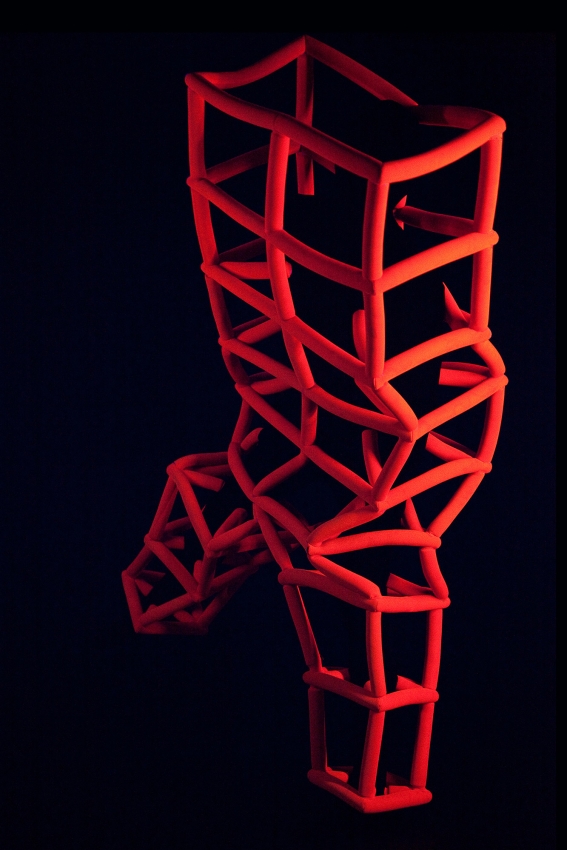
Roman Ermakov
Роман Ермаков
live sculpture
Our perception — the only true reality. Creation as a feeling that generates the image, expressed in the form. Beauty manifesto calling to go beyond that limit imagination. The aesthetics of art can not be reduced to a clear set of building blocks with which you can strengthen or weaken the perception of contrast. Beauty should not be subjected to analysis, that is communication and the call to participate in the transformation of the emotional to the visible.The process of creating — is the alignment of the mosaic, many repetitions of simple and pure elements, which form a collection, harmonious in its incompleteness.

Theo Triantafyllidis
Ritual
An undisclosed location. Dry land under a scorching sun. Something abominable has happened here in recent memory. Now a ritual is taking place. The remains of what was once human are flickering in darkness. Nature is reclaiming what is hers. She is savage and unforgiving. She is laughing at us. Her sinister laughter echoes in the emptiness. Ritual re-imagines the notion of site-specificity within the mediated landscape. The digital and physical work for this exhibition sit in a forgotten mining town somewhere in the California desert. The viewer is invited to interact with Triantafyllidis’ new live simulation, sculptures and custom electronics blurring the line between the real life and online experience
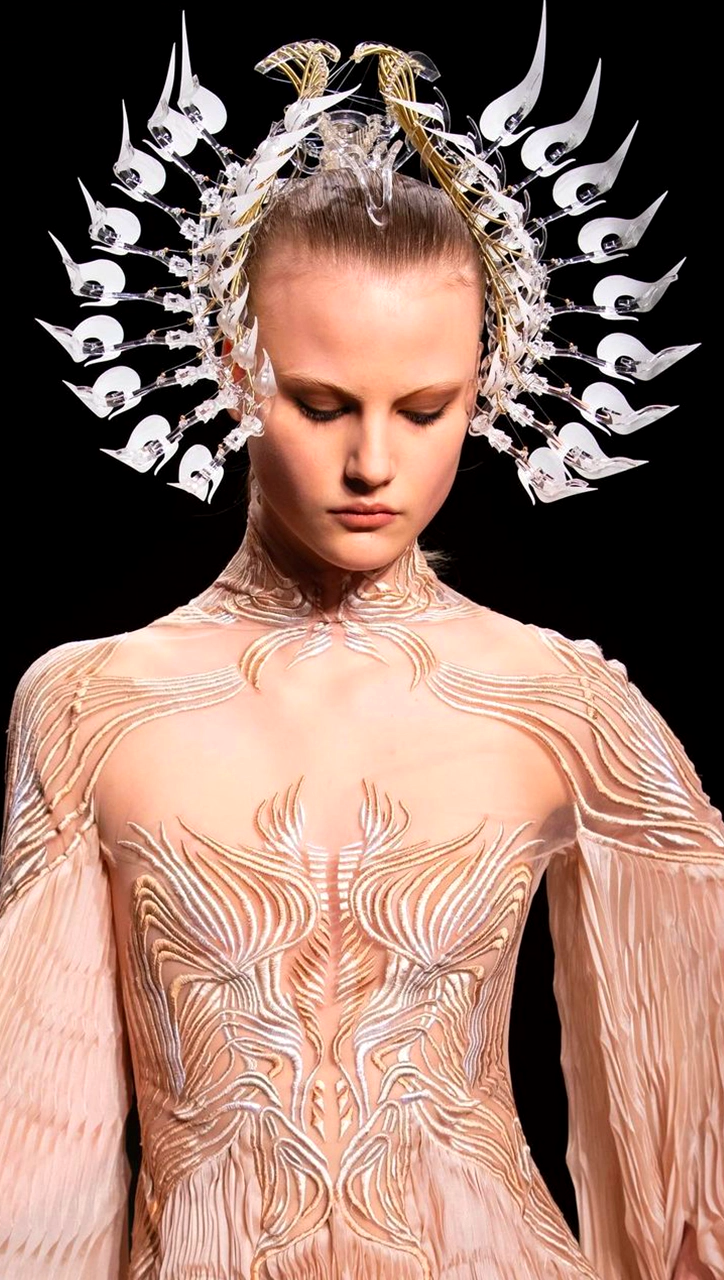
Casey Curran & Iris Van Herpen
Kinetic Sculptures
The ‘Minds in Motion’ crown is made in collaboration with artist @casey_curran. Eighteen transparent monofilament threads meander through a series of brass coils, engineered to continuously shape-shift its silhouette.

Studio Above&Below
‘Semi-Diurnal Spaces’ is a site specific immersive installation in form of a full dome which makes use of local tidal and atmospheric data of South Wales. Locals were invited to experience their close-by waterbody through a meditative environment, connecting to it in a poetic, technological and tele present way. Tidal patterns and atmospheric data such as wind and humidity influence a digital NVIDIA FleX particle system in real-time. The site-specific data influences the gravitational forces, fluid viscosity and flow rate within the dome as a body, resulting in a living digital sculpture and AV experience connecting to aspects of the channel itself.

Amigo & Amigo
Affinity
Affinity is an immersive interactive light and sound installation inspired by the human brain. Each light globe represented a memory, as people approached Affinity different memories could be heard. When people touched the memory a light would trigger, the longer they touched the further their light would travel throughout the sculpture. Affinity features 62 different colour combinations and 112 points of interaction.

HUGH KRETSCHMER
休克雷奇默尔
ХЬЮ КРЕЧМЕР
guggenheim
Décrivant son travail comme « une fusion de différentes influences absorbées depuis des années », l’artiste tire principalement ses inspirations des peintures et sculptures du XXIe siècle. Travaillées et colorées, ses œuvres humoristiques, cyniques et ironiques sont une véritable mise en scène du quotidien. Amateur de la juxtaposition et de ses manipulations virtuelles, l’artiste-sculpteur d’images, fait entrer le spectateur dans un tourbillon imaginaire façonné par sa main.

Jordan Wolfson
요르단 울프슨
ジョーダンウォルフソン
Female Figure
The stare of the animatronic sculpture is so intense, it would put anyone uncomfortable. The mask is probably there as a way to avoid creating a human face using animatronics but it also definitely adds to the creepiness of the overall look. The importance of the gaze is found throughout Wolfson’s work but it finds here a very special interpretation. He gives the ability to gaze to two different entities, a stripper and a robot, who are by definition never supposed to look up. The visitor is no longer in control of the situation, creating the awkwardness that is at the core of the work.

Alexandr Grigorev
Scraps n19
This virtual sculpture impossible to create in physical world but still looks really real. It’s an example of post-reality that widely used in my practice.

Urs Fischer
CHAOS #501
Introducing CHAOS, 501 original works in the form of unique digital sculptures. Each NFT in CHAOS consists of two unique objects (an array of familiar objects to people today) that have been 3D scanned. They are set on a colliding course in motion and orbit. The sculptures, operating as an archeology of the present, are intended to manifest in any format that is capable of displaying, playing or showing a 3D sculpture in motion. The culmination of the project is CHAOS #501, a single entity NFT uniting all one-thousand objects represented in #1-#500.

Pangenerator
The abacus
THE ABACUS is probably the first ever 1:1 interactive physical representation of real, functioning deep learning network, represented in the form of a light sculpture. The main purpose of the installation is to materialise and demystify inherently ephemeral nature of artificial neural networks on which our lives are becoming increasingly reliant on. As the part of new permanent exhibition devoted to the Future the installation aims to engage and educate the audience in artistically compelling ways being the manifestation of art and science movement goals.
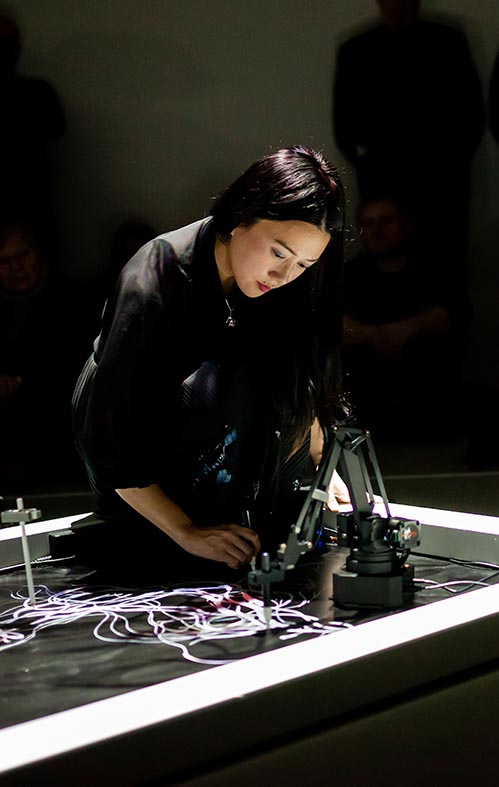
Sougwen Chung
愫君
Drawing Operations
Sougwen Chung is an internationally renowned multidisciplinary artist, who uses hand-draw and computer-generated marks to address the closeness between person-to-person and person-to- machine communication. She is a former researcher at MIT Media Lab and current Artist in Resident at Bell Labs and New Museum of Contemporary Art in New York. Her speculative critical practice spans installation, sculpture, still image, drawing, and performance. Drawing Operations Unit: Generation 1 is the 1st stage of an ongoing study of human and robotic interaction as an artistic collaboration.

JF Malouin
Les trois Grâces
file festival
“Les Trois Grâces” is a presence and corporeality simulation in virtual reality. Exposing the underlying power struggle implied within touch, this piece explores the trespassing of bodily frontiers and territoriality. As a sculpture, its object is not matter, but our relationship to the other.
It offers a troubling experience of intimate proportions.

JOSIAH MCELHENY
Interactions du corps abstrait
Avec “Interactions of the Abstract Body”, McElheny a poussé ces idées plus loin, créant un ensemble de travaux vaste et varié qui examine comment la mode et le modernisme se sont entrecroisés et influencés, en particulier à travers le langage commun du corps. Fondamentalement, McElheny a animé cette dynamique avec la présence constante d’un interprète. En combinant une performance continue en chair et en os avec une sculpture statique dans le même espace de galerie, une première pour White Cube, McElheny rompt radicalement la distinction entre performance et exposition.

Davide Balula
Mimed Sculptures,(Henry Moore, Moon Head)
“Artistas vestidos com uniformes brancos e luvas de manuseio de arte rosa se movem em torno de pedestais de vários tamanhos. Eles gesticulam, imitando os contornos de esculturas – Le-nez de Giacometti (1947), Hang up de Eva Hesse (1966) e Paisagem inconsciente de Louise Bourgeois (1967 -8), entre outros.
Como se fosse um jogo de charadas da história da arte, você se pega adivinhando com o que eles estão manipulando, qual é a superfície e a textura dos objetos. Através dessa performance, a nova relação sensual com essas obras é formada. No entanto, você não pode deixar de fazer a conexão com o comentário sobre a arte de manipular em si – pode o mundo da manipulação de arte, instalação de exposições e, de fato, venda de obras de arte estar se tornando tanto uma arte quanto a própria obra de arte? ” Maisie Skidmore

Playmodes Studio
“Espills” is a solid light dynamic sculpture. Built using laser beams, laser scanners and robotic mirrors, it is inspired by crystalline formations. A set of geometric figures that float in the air and which suggest, in an abstract way, the transmutation of matter from chaos to order. Dust becoming crystal, being eroded and becoming sand again.

zach blas
sanctum
Zach Blas(United States、1981)の作品は、テクノクラート社会の限界と基盤を描くことを目的として、視覚言語の慣習、価値体系、デジタル技術に内在する力のダイナミクスをさまざまな文脈で分析、調査、配置しています。 。 彼の分析とデジタル文化への反映のために、彼は映画、彫刻、執筆、パフォーマンスなど、さまざまな表現形式を使用しています。 ブラスはブラックユーモアと理論的研究に取り組んでおり、彼の最も顕著な影響の中には、神秘主義の伝統、サイエンスフィクションのジャンル、ポップカルチャー、クィアの美学があります。
.
sanctum
The work of Zach Blas (United States, 1981) analyzes and explores the dynamics of visual language practices, value systems, and the forces inherent in digital technology in a variety of contexts, with the aim of depicting the limits and foundations of technocratic societies. I have placed it. .. For his analysis and reflection in digital culture, he uses a variety of forms of expression, including film, sculpture, writing and performance. Brass works on black humor and theoretical research, and among his most prominent influences are the mystical tradition, the genre of science fiction, pop culture, and the aesthetics of queer.

Daniel Widrig
‘SnP’, 2018, recycled plastic, injection moulded
“Widrig’s art breaks down the boundaries between disciplines; borrowing tools traditionally associated with one industry and using them in other fields, in often unanticipated and exciting ways. Widrig uses computer simulation processes and advanced technologies adopted from the special effects business to create sculptural 3D-printed craftwork—digital designs materialize into intricate sculptures in glass or recycled plastic and furniture pieces with impeccable undulated thin surfaces,” Devid Gualandris

Keith Lam
Heliocentric
“Heliocentric” is a lighting sculpture represents the movement of universe. It dialogues to its history (from temple to school to creative hub) and its functionality (welcoming people connect and learn the universe)
With the lighting arrangement, kinetic movement of the light, and the performer , it shows the relationship between universe, knowledge and human.

Lukas Truniger, Itamar Bergfreund & Bruce Yoder
Ethereal Fleeting
A series of clouds is generated by a machine-like sculpture. They appear, float over the surrounding environment and then dissolve into thin air again. The delocalization of this instant of natural beauty evokes a surreal experience. The installation forms a juxtaposition of a metallic structure and synthetic imitations of clouds. This supposed contrast between human technology and nature is explored in a space of unseen possibilities for symbiosis.

MARCO BAROTTI
MOSS
Depuis le début de la pandémie, la pollution de l’air a diminué dans de nombreuses régions du monde. Nous assistons à un moment sans précédent en termes de réduction des émissions industrielles et de l’empreinte carbone. Moss est une sculpture sonore cinétique alimentée par des données sur la qualité de l’air générées par l’indice mondial de la qualité de l’air. La sculpture vivante est conçue pour analyser l’air de nos villes et réinterpréter les données avec des modes de respiration et des paysages sonores en évolution. De Berlin à Bombay, Moscou et Pékin. Le public peut expérimenter en temps réel la qualité de l’air du monde transformée en une installation sonore cinétique. Le projet contribue à la recherche mondiale et incite les citoyens à participer au débat sur la qualité de l’air et la démocratie sur terre. Moss vise à créer un engagement civil en apprenant de la sagesse de la nature et du service de la technologie.

Marco Barotti
PALOURDES
Dans la nature, les palourdes sont des détecteurs de polluants ; ils servent de minuscules systèmes de filtration. Clams est une collection de sculptures sonores cinétiques qui convertissent les données des capteurs de qualité de l’eau en sons et en mouvements. Chaque « palourde » est fabriquée à partir de déchets plastiques recyclés et contient un haut-parleur. Le paysage sonore microtonal en constante évolution confère à chaque coque une action d’ouverture et de fermeture subtile et réaliste. Les lectures en temps réel d’un capteur de pureté de l’eau standard placé dans la rivière, le lac ou la mer des villes où l’œuvre d’art est présentée, constituent la base de la musique, qui est générée par un processus en constante évolution basé sur les niveaux de qualité de l’eau sur temps. Les palourdes invitent le public à établir des liens entre l’art médiatique, la sonification des données et la durabilité environnementale.

Stine Deja
Cold Sleep
Right now, approximately 400 human bodies are frozen at -196 degrees Celsius in America and Russia. They are dead – legally speaking. The hope is to one day defrost and resuscitate them. The procedure is controversial. Nonetheless, cryopreservation, i.e. preserving people at extreme temperatures below zero, is an area marked by growth. The condition is sometimes referred to as ‘cold sleep’, which is also the title of Stine Deja’s first solo show in Denmark at Tranen. The exhibition is an installation of kinetic sculpture and animation. Cryopreserved bodies in thermal, yellow suits are suspended in big, circular aluminium structures revolving around their own axis on small islands in a desert landscape. In the sand lie craters where artificially inseminated cells divide. A barren desert landscape is usually seen as lifeless and abstract. In Deja’s version it becomes a place for being before or after human life, or, as the artist has it, “a population in another dimension.”

Helen Pashgian
LIGHT
“Helen Pashgian is a pioneer and pre-eminent member of the California Light and Space Movement. Her signature forms include columns, discs and spheres in delicate and rich coloration, often with an isolated element suspended, embedded or encased within. Pashgian’s innovative application of industrial epoxies, plastics and resins effect semi-translucent surfaces that simultaneously filter and contain illumination. Activated by light, these sculptures resonate in form and spatiality, both inner and outer.” Dimitris Lempesis

LEO VILLAREAL
CYLINDRE
Dans cette installation étincelante intitulée Volume, l’artiste Leo Villareal a pris une poignée d’étoiles scintillantes et les a ramenées sur terre. La partie cylindrique était suspendue au plafond et contenait plus de 20 000 lampes LED en acier inoxydable réfléchissant et hautement poli, qui créaient un espace tridimensionnel dans lequel la lumière pouvait prendre vie. Les modèles d’éclairage, contrôlés par la conception du code logiciel de Villareal, se déplacent à différentes vitesses, cycles d’allumage et d’extinction et vagues de luminosité et d’obscurité. Selon un critique, « la pièce est un poème d’argile éblouissant qui attire le spectateur dans un espace abstrait profond tout en déformant la perception temporelle et visuelle. » Villareal n’est pas un débutant en matière de sculptures lumineuses étonnantes. Découvrez ce tunnel de spectacle de lumière de 200 pieds qu’il a installé sur l’allée du hall des bâtiments est et ouest de la National Gallery of Art. L’espace entre les installations de Villareal et son public est un facteur important car les spectateurs sont entrelacés avec les lumières qui pulsent tout autour.

Marco Barotti
The Egg
Ten thousand years ago, there were 1 million people living on the planet, fifty years ago there were 3 billion of us and, by the end of this century, we are estimated to reach a population of 10 billion people! We have modified almost every part of our planet and, as we continue to grow, our need for vital resources increases exponentially. We human beings are the main force behind every global problem we face. The work is a kinetic sound sculpture resembling an egg. The cycle of life, reflected in the shape of the sculpture with neither beginning nor end, symbolizes fertility and reproduction – and thus questions the impact of overpopulation. Driven by real-time data generated by the Worldometer, the sculpture constantly changes its shape.

ScanLAB
Replica
We begin with a tour of a virtual 3D model of the London house-cum-museum built by 19th-century architect Sir John Soane. The journey traverses the five floors of the museum’s meticulously restored rooms, each filled with original and duplicate fragments of antiquity. Sir John Soane (1753-1837) was one of the foremost British architects of the Regency era, a Professor of Architecture at the Royal Academy, and a dedicated collector of paintings, sculpture, architectural fragments and models, books, drawings and furniture. Soane was awarded the Royal Academy’s prestigious Gold Medal for Architecture, as a result receiving a bursary (funded by King George III) to undertake a Grand Tour of Europe. His travels to the ruins of Ancient Rome, Paestum and Pompeii would inspire his lifelong interest in Classical art and architecture. As an enthusiastic collector, later in life he began to repurpose his home at Lincoln’s Inn Fields as a Museum for students of architecture. With a collection containing thousands of objects ranging from Ancient Egyptian antiquities and Roman sculpture to models of contemporary buildings, Soane’s house had become a Museum by the time of his death.

Maarten Vos, Christopher Bauder, Boris Acket
SECHS
SECHS brings Bach’s heritage together with modern composition techniques and a refined kinetic light sculpture – emphasizing and re-interpreting his innovation in symmetry, repetition and composition. Following the likes of Wendy Carlos’ critically acclaimed ‘Switched on Bach’ — the first electronic interpretation of Bach’s work — and later re-interpreters such as Max Richter for Vivaldi, Acket & Vos present this completely new rendering of one of the world’s most influential composers. Together with the kinetic light sculpture by Christopher Bauder and spatial sound innovators 4DSOUND the composition is translated to a spatial immersive experience.

UJOO LIMHEEYOUNG
Machine Tree
Machine with Tree is a kinetic sculpture combining dead trees with metal machinery. It is designed to use the object’s center of gravity to achieve a movement where the tree appears to float in midair. In Machine with Tree, a dead tree is placed at the end of a long, sharp rod on the machine. The tree slowly moves back and forth with the machine’s movements, as though floating in midair. Through its creation of artificial, bizarre movements controlled by machinery, it illustrates a melancholy contemplation of the strange and contradictory things woven together by our reality.
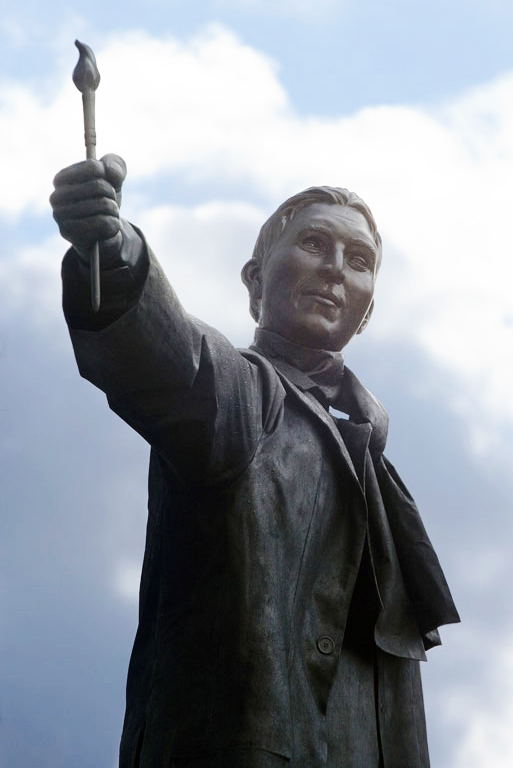
Greyworld
Monument to the Unknown Artist
At first glance, Monument to the Unknown Artist appears to be a simple bronze statue, dressed in a neck scarf and loose fitting suit. However, the six meter monument seeks inspiration from passers-by, inviting them to strike poses which he copies, continually changing his form in a light-hearted and mischievous way. The unique sculpture offers an alternative and accessible creative experience for the public allowing them to create a dialogue with the work of art.

Cy Keener
Agulhas Drifter
Agulhas Drifter est un nouveau projet d’art médiatique passionnant qui présente les conditions des vagues en haute mer aux visiteurs de la galerie. En juin 2018, Sai Keener a lancé une bouée en verre soufflé personnalisée le long de la rivière Agulhas au large de Durban, en Afrique du Sud, et a créé un système lumineux et sonore immersif qui répond aux formes d’onde des satellites en temps quasi réel. La bouée enregistre le tangage, le roulis et l’accélération verticale des vagues, enregistre la température de surface de la mer et surveille les courants. Ces données sont transmises par satellite toutes les huit heures. L’installation de la galerie utilise les dernières données de mouvement des vagues en utilisant une sculpture cinétique pour projeter une ligne d’horizon changeante de lumière laser à travers la salle de la galerie afin de visualiser les conditions océaniques actuelles.

TEAMLAB
Massless Clouds Between Sculpture and Life
Жизнь – это порядок энергии. В пространстве произведений искусства создается порядок энергии, как и в жизни. Образуется огромная белая масса, которая плывет вверх. Это можно рассматривать как визуализацию порядка или энергии. Скульптура, гигантская белая масса, парит между полом и потолком в пределах пространства, неопределенная форма меняется, как бы выходя за рамки концепции массы. Граница между этой парящей скульптурой, пространством и телом зрителя неоднозначна, и люди могут погружать свое тело в эту скульптуру. Даже когда люди проталкивают скульптуру и ломают ее, она естественным образом восстанавливается, как живое существо. Но, как и в случае с живыми существами, когда скульптура разрушается сверх того, что она может восстановить, она не может восстановить себя и разрушается. Даже если люди попытаются сдвинуть или толкнуть эту парящую скульптуру в воздухе, они не смогут этого сделать. Если они поднимут ветер, облако разорвется. Мы понимаем, что простое действие человека не может сдвинуть эту скульптуру.

Kutin | Kindlinger
ROTOЯ
The Rotor is equipped with a four channel speakersystem and a 360° camera. The artists control the speed of it’s rotation which directly influences the projected video-images as well as the sound-characteristics and the perception of the object itself. Acceleration & deceleration become main parameters, which enables the artists to compose an otherworldly piece that seems to follow it’s own logic. A strange communication between audio, video, object and light establishes itself and seduces the audience. There is the hypnotic movement of the sculpture while inevitable auditory and visual feedback is used as a central aesthetic element: The rotating speakers are amplified by static microphones, provoking complex feedback loops and patterns, that trigger psychoacoustic sensations.
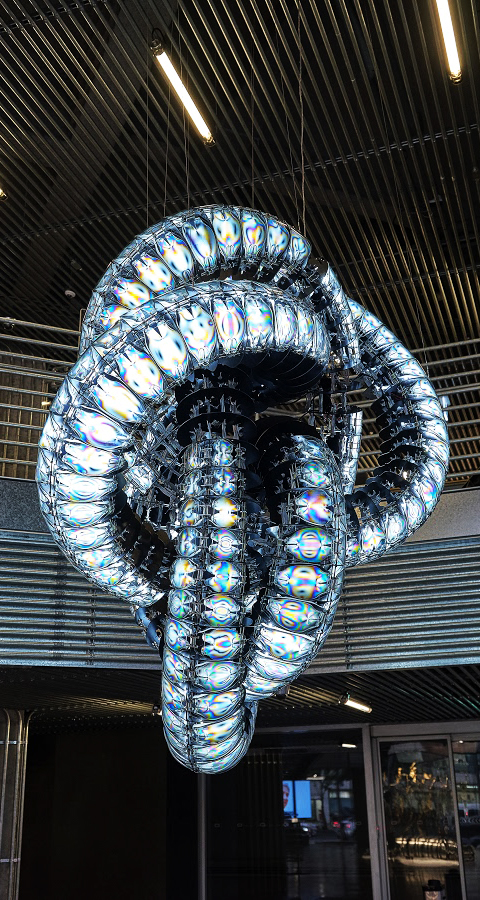
YUNCHUL KIM
CHROMA III
Kim ist bekannt für seine mechanischen Skulpturen, die wissenschaftliche und mathematische Theorien einbeziehen, und auch als Komponist elektroakustischer Musik. Für diese Triennale präsentiert Kim Chroma III, das die Knotentheorie in der Mathematik anwendet, um Hunderte von Polymerzellen […]
.
Kim is known for his mechanical sculptures that incorporate scientific and mathematical theories and also as a composer of electroacoustic music. For this Triennale, Kim presents Chroma III, which applies knot theory in mathematics to structure hundreds of polymer cells […]

maurizio cattelan
blind
It’s an image that evokes a moment in history seared into our collective consciousness. This is “Blind” by Italian artist Maurizio Cattelan. The sculpture of an aircraft spearing a towering monolith recalls the 9/11 attack on New York’s Twin Towers. The simple black pillar carries a heavy meaning. It’s the final artwork in a new Milan exhibit called “Breath Ghosts Blind”.

